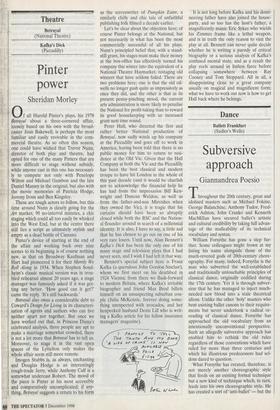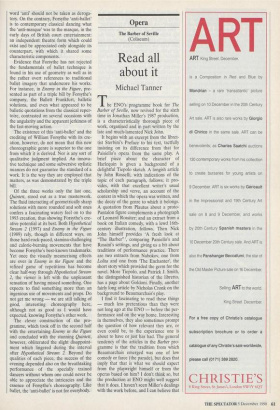Dance
Ballett Frankfurt (Sadler's Wells)
Subversive approach
Giannandrea Poesio
Throughout the 20th century, great and idolised masters such as Michael Fokine, George Balanchine, Anthony Tudor, Fred- erick Ashton, John Cranko and Kenneth MacMillan have secured ballet's artistic and cultural credibility by taking full advan- tage of the malleability of its technical vocabulary and syntax.
William Forsythe has gone a step fur- ther. Some colleagues might frown at my listing his name alongside those of the much-revered gods of 20th-century chore- ography. For many, indeed, Forsythe is the man who subverted the well-established and traditionally untouchable principles of classical dance, originally codified during the 17th century. Yet it is through subver- sion that he has managed to inject much- needed new blood into a stale theatrical idiom. Unlike the other 'holy' masters who bent existing ballet canons to their require- ments but never undertook a radical re- reading of classical dance, Forsythe has approached the old vocabulary from an intentionally unconventional perspective. Such an allegedly subversive approach has enabled him to rethink the old rules regardless of those conventions which have ruled for more than three centuries and which his illustrious predecessors had sel- dom dared to question.
What Forsythe has created, therefore, is not merely another choreographic style that feeds on an existing formal technique but a new kind of technique which, in turn, feeds into his own choreographic style. He has created a sort of `anti-ballet' — but the word 'anti' should not be taken as deroga- tory. On the contrary, Forsythe 'anti-ballet' is to contemporary classical dancing what the 'anti-masque' was to the masque, in the early days of British court entertainment: an independent theatre form which could exist and be appreciated only alongside its counterpart, with which it shared some characteristic components.
Evidence that Forsythe has not rejected the fundamentals of ballet technique is found in his use of geometry as well as in the rather overt references to traditional ballet imagery that underscore his works. For instance, in Enemy in the Figure, pre- sented as part of a triple bill by Forsythe's company, the Ballett Frankfurt, balletic solutions, and even what appeared to be balletic quotations from the classical reper- toire, contrasted on several occasions with the angularity and the apparent jerkiness of the fast-moving action.
The existence of this 'anti-ballet' and the crediting of William Forsythe with its cre- ation, however, do not mean that this new choreographic genre is superior to the one from which it is derived. Nor is any sort of qualitative judgment implied. An innova- tive technique and some subversive stylistic nuances do not guarantee the standard of a work. It is the way they are employed that matters, as was demonstrated by the triple bill.
Of the three works only the last one, Quintett, stood out as a true masterwork. The fluid interacting of geometrically sharp solutions with more rounded and soft ones confers a fascinating watery feel on to the 1993 creation, thus showing Forsythe's cre- ative potential at its best. Both Hypothetical Stream 2 (1997) and Enemy in the Figure (1989) rely, though in different ways, on those hard-rock-paced, stamina-challenging and calorie-burning movements that have become Forsythe's best-known trademarks. Yet once the visually mesmerising effects are over in Enemy in the Figure and the refined game of repetitions has become clear half-way through Hypothetical Stream 2, the viewer is left with the unpleasant sensation of having missed something. One expects to find something more than an ingenious use of movements and props. Do not get me wrong — we are still talking of good, interesting choreography here, although not as good as I would have expected, knowing Forsythe's other work.
The clever construction of the pro- gramme, which took off in the second half with the entertaining Enemy in the Figure and concluded with the stunning Quintett, however, obliterated the slight disappoint- ment which lingered during the interval after Hypothetical Stream 2. Beyond the qualities of each piece, the success of the evening depended also on the breathtaking performance of the specially trained dancers without whom one could never be able to appreciate the intricacies and the essence of Forsythe's choreography. Like ballet, the 'anti-ballet' is not for everybody.



















































































 Previous page
Previous page